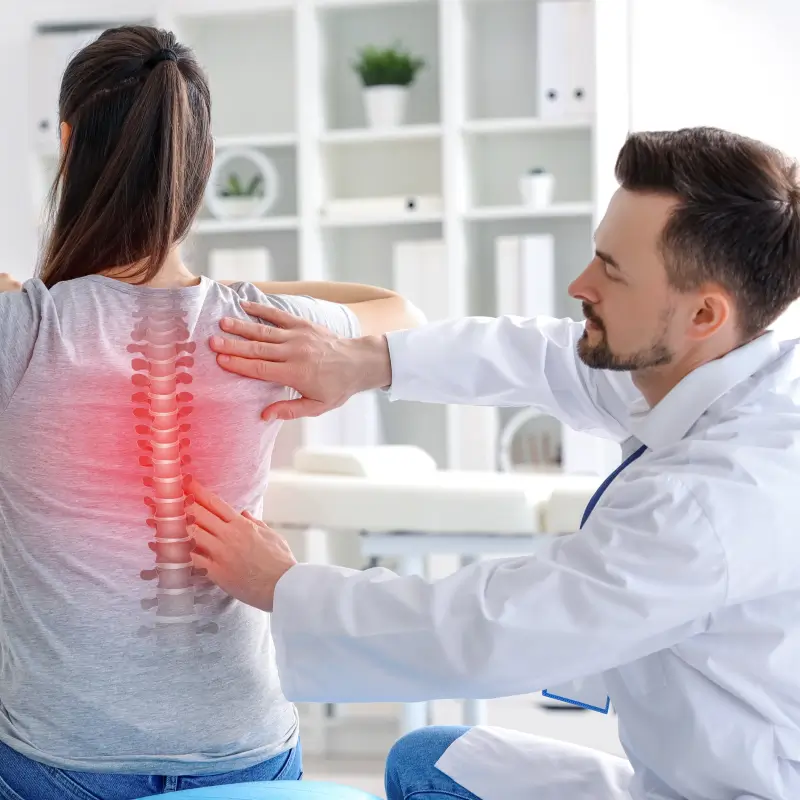Home/Wellness Zone/Sakra Blogs
13th Oct, 2025

Back pain is one of the most common health issues affecting people across all age groups. It can feel like a dull ache, a sharp stab, or a persistent stiffness that limits your movement. Lower back pain is especially common, as it bears most of the body’s weight and supports daily motion. Knowing the lower back pain causes, symptoms, and treatments can help you take the right steps toward lower back pain relief.
There are several reasons for lower back pain, and they often involve the muscles, ligaments, discs, or nerves in the spine. Understanding these can help you prevent the pain from becoming chronic.
Muscle or Ligament Strain:
This is one of the most frequent causes. It occurs when you lift something heavy, twist awkwardly, or overuse your back muscles. Even a sudden movement can cause a small tear in the muscle fibers, leading to inflammation and pain.
Herniated or Bulging Disc:
Discs are soft cushions between your spinal bones. When one slips or bulges out, it can press against nearby nerves, resulting in sciatic nerve pain that radiates from the lower back down the leg.
Degenerative Disc Disease:
With age, spinal discs lose flexibility and cushioning. This wear and tear can lead to stiffness, chronic lower back pain, or difficulty bending and sitting for long periods.
Arthritis and Spinal Stenosis:
Arthritis can damage the joints in your spine. In some cases, it causes narrowing of the spinal canal (stenosis), which puts pressure on nerves and leads to pain, tingling, or weakness in the legs.
Poor Posture and Sedentary Lifestyle:
Sitting for long hours, using the wrong chair, or slouching can strain spinal muscles. A lack of physical activity weakens the core muscles that support your spine, increasing the risk of back pain.
Injury or Trauma:
Accidents, falls, or sports injuries can damage spinal structures or muscles, leading to long-term pain if not treated properly.
Back pain symptoms can vary depending on the cause. You may experience:
Dull or sharp pain in the lower back
Pain spreading to the buttocks or legs
Stiffness or reduced movement
Muscle spasms
Numbness or tingling in the legs (sciatica)
If your pain doesn’t improve after a few weeks or comes with weakness, numbness, or loss of bladder control, you should see a doctor immediately.
Most cases of lower back pain can improve with simple, non-surgical treatments. Some effective options include:
Lifestyle Modifications:
Staying active, maintaining good posture, and avoiding heavy lifting can help relieve strain on your spine. Gentle stretching and light exercise, such as walking or yoga, support lower back pain relief.
Medications:
Over-the-counter painkillers and anti-inflammatory drugs can reduce discomfort and swelling. In some cases, doctors may prescribe muscle relaxants or stronger medication.
Physical Therapy:
A physiotherapist can teach exercises that strengthen back and core muscles, improve flexibility, and prevent future episodes of pain.
Minimally Invasive Procedures:
For persistent pain, treatments like steroid injections or nerve blocks can offer targeted relief and reduce inflammation around spinal nerves.
Surgery:
Surgery is only needed when conservative methods fail or when the pain is caused by serious spinal problems like herniated discs or spinal stenosis.
Preventing lower back pain starts with simple lifestyle choices. Here are some practical tips:
Exercise regularly: Strengthen your back and core muscles through activities like swimming, stretching, or yoga.
Maintain good posture: Sit straight, keep your shoulders back, and use an ergonomic chair when working long hours.
Lift carefully: Bend your knees, not your waist, when picking up heavy objects.
Stay at a healthy weight: Extra weight puts stress on your lower spine.
Take breaks: Avoid sitting or standing in one position for too long.
Sleep properly: Use a firm mattress and sleep on your side or back to support your spine alignment.
Lower back pain can affect anyone, from office workers to athletes. While it can be frustrating, most cases are treatable with simple changes and timely medical care. Understanding the lower back pain causes and recognizing back pain symptoms early can prevent long-term damage. If your pain persists or worsens, it’s important to consult a spine specialist to explore the right treatment plan for lasting lower back pain relief.
1. Is lower back pain serious?
Not always. Most cases are mild and improve with rest, exercise, and posture correction. However, if pain persists for more than a few weeks or causes numbness or weakness, it’s important to seek medical attention.
2. Can stress cause lower back pain?
Yes. Stress can lead to muscle tension, especially around the shoulders and lower back, which can trigger or worsen pain.
3. How can I relieve lower back pain at home?
You can try hot or cold compresses, gentle stretching, and maintaining good posture. Avoid lying in bed for long periods, as movement helps recovery.
4. When should I see a doctor for lower back pain?
If your pain is severe, persistent, or radiates down your legs, or if you experience numbness, tingling, or bladder issues, consult a doctor immediately.
5. What exercises help with lower back pain relief?
Low-impact exercises like walking, swimming, and yoga can strengthen your back muscles and improve flexibility without straining your spine.
Enquire Now
